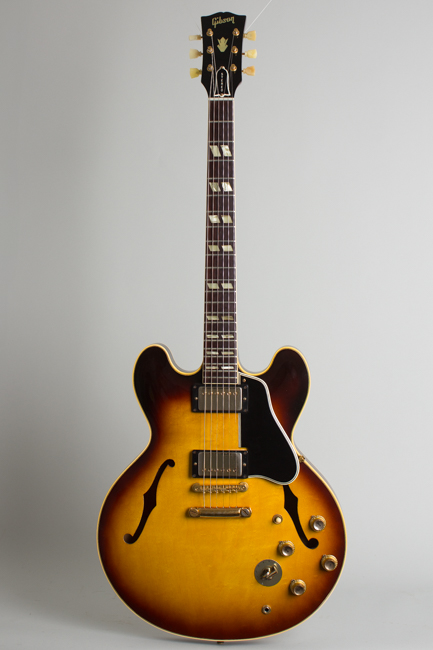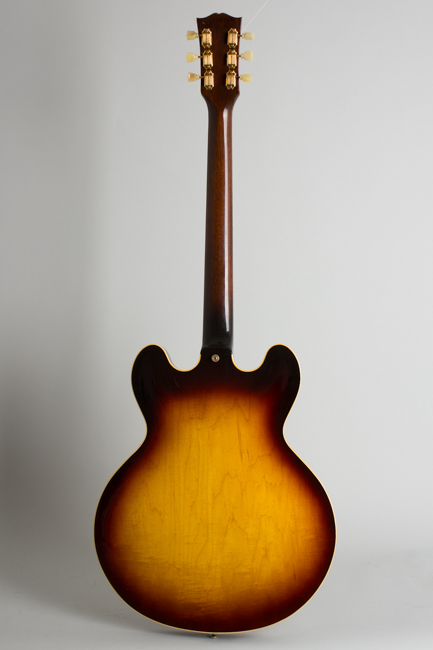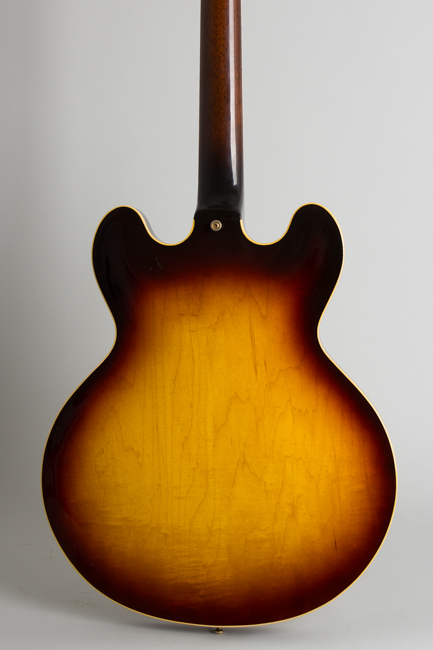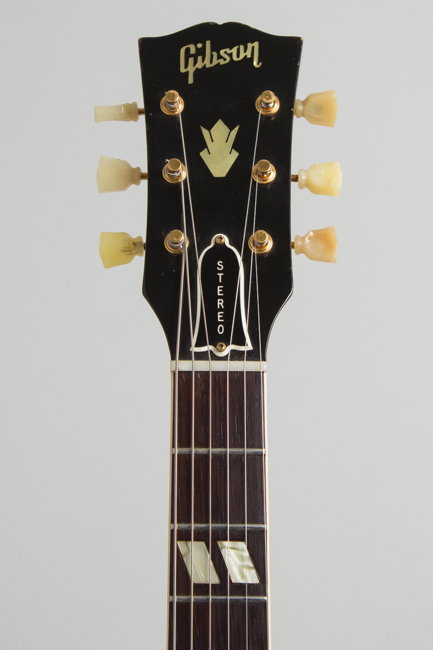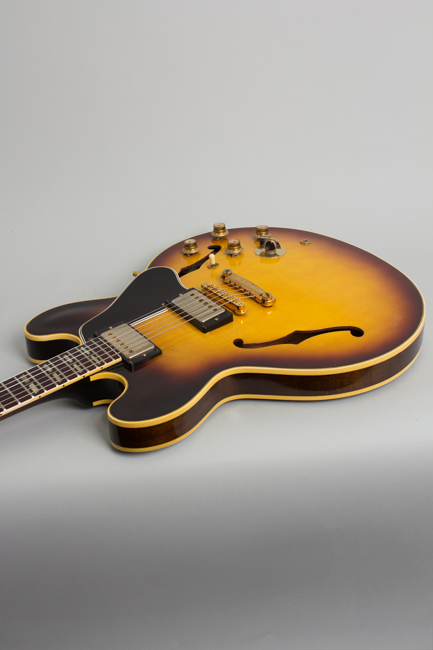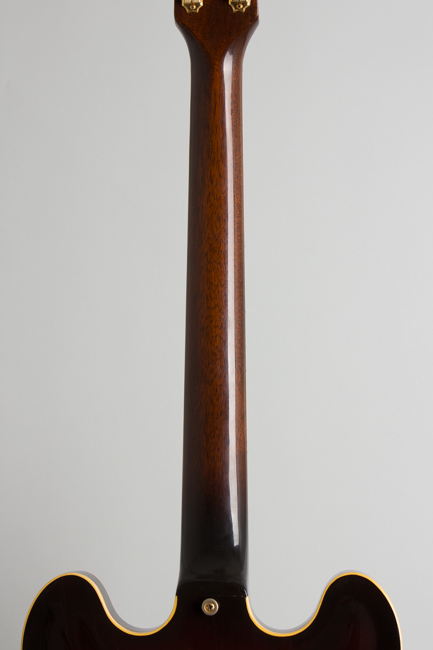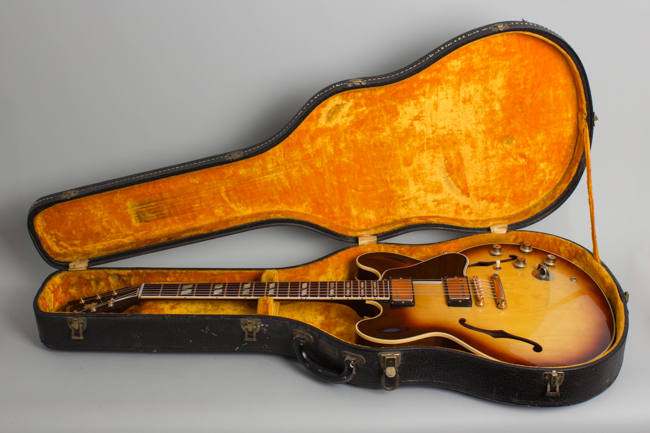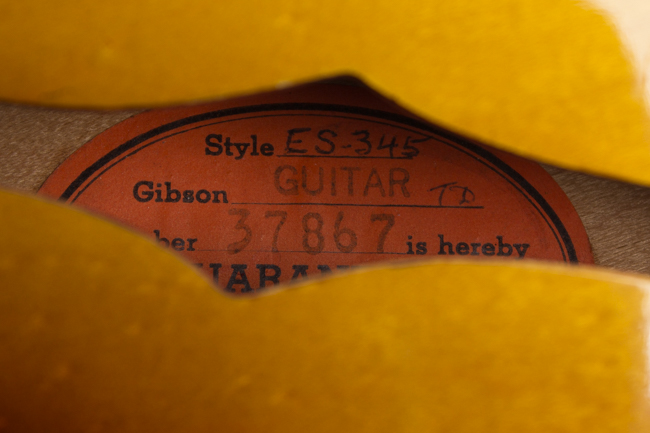Gibson ES-345TD Semi-Hollow Body Electric Guitar (1961)
Gibson ES-345TD Model Semi-Hollow Body Electric Guitar (1961), made in Kalamazoo, Michigan, serial # 37867, sunburst lacquer finish, laminated maple body; mahogany neck with rosewood fingerboard, original black hard shell case.
The ES-345, Gibson's original "Stereo" guitar, was a product of the late 1950s fascination with "better living through Electronics" that inspired several makers to "channel" their efforts into ostensibly stereo-output instruments. Essentially a somewhat fancier version of the recently launched thinline semi-hollow ES-335, the 345 was added to the line in spring 1959. This mid/late-1961 example has two gold plated PAF pickups and the fairly thin, flatter neck profile characteristic of 1960-61, though a bit chunkier and not ad dead flat feeling as some.
This model dressed up the 335 template a bit, adding gold plating, a bit of extra binding and trapezoid pearloid fingerboard inlay to the design. Its real raison d'etre was the new stereo/Vari-Tone wiring rig, which was in with the hot trends at the time. Gibson's stereo wiring sent the signal from each pickup to a different amplifier (or different channel of the same amp) while the Vari-Tone was a 6-position notch filter which gradually brightened and thinned out the characteristically rich tone of the humbucking pickups. This one has the gold 6-pisition plate topped with the gold knob characteristic of earlier examples. The ES-345 was originally designed to pair perfectly with Gibson's GA-79 stereo amplifier.
The ES-345 proved a fairly popular guitar in the 1960s, with signature users running the gamut from jazz to blues (most notably Freddie King) to prominent British invasion players, including Pretty Thing Dick Taylor, Tony Hicks of the Hollies (who used one extensively), Eric Stewart of the Mindbenders and (briefly) Beatle George Harrison. Still, this was a fairly expensive guitar, listing at $395 in September 1961, plus $50 for the #519 "Faultless" case. All of 466 of these shipped in 1961 which is a decent number for Gibson in that period at this price point, but far less than were sold later in the 1960.
This guitar is set up with an original gold stop tailpiece; like many ES-345s at one point it was fitted with a vibrato tailpiece, in this case the company's then-new side-to-side unit, a standard fitting in the early 1960s. There are actually two sets of filled holes on the back rim about 3/8" apart for this and the strap button, showing the unit was moved sideways at one point; all these have been neatly filled in and lightly finished over. The stud holes in the top of this guitar are original and were not added later. The tailpiece itself is a correct period piece, mated to the original no-wire ABR-1 Tune-O-Matic bridge.
The current "stoptail" setup is generally held to enhance playability, giving an adjustable angle to the bridge off the tailpiece which can be steeper than the typical vibrato setup, increasing string break angle over the saddles. It also makes the guitar substantially lighter on the strap! In 1965 a trapeze tailpiece was fitted as standard and the "stoptail" configuration was no longer an option. This guitar is otherwise completely original and a simply splendid instrument, stunning to look at and a joy to play.
Overall length is 42 in. (106.7 cm.), 16 in. (40.6 cm.) wide at lower bout, and 1 5/8 in. (4.1 cm.) in depth, measured at side of rim. Scale length is 24 3/4 in. (629 mm.). Width of nut is 1 11/16 in. (43 mm.).
This ES-345 is a really superb example, showing only VERY light wear overall; just a super well preserved guitar. The sunburst lacquer finish still shines like it did when JFK was in the White House with only a few small marks on it, mostly tiny dings to the headstock edges with a few miniscule touch-ups there. The original frets and fingerboard are very clean, with hardly any wear to the board and evidence of a very light polish work on the fretwire. The most notable wear is to the gold plating, which is heaviest on the pickup covers and tailpiece. The painted gold Varitone knob is worn as well.
The hardware remains original and intact with a couple of minor exceptions. Two of the original tuner buttons crumbled away and were replaced with exact repros; the high E string button shops some shrinkage but is still functional. The rear tone pot has the outer "can' removed and a small clip was added under the top securing the wire in this area (perhaps it was causing a buzz!). As noted there was a Gibson side-to-side trem unit mounted at one point, in two slightly different positions but the guitar is currently set up with an original stop tailpiece and studs. There is no shadow from this on the top, just the patched holes on the lower rim.
The original stereo-Varitone wiring is intact and unaltered. The guitar plays and sounds exactly as it should, with the classic tones heard on literally hundreds of vintage recordings made with this model. The original yellow-lined black case has some minor external wear but is quite solid and attractive. This is a really great 345, a fabulous survivor of the original stereo era of guitars and a true Gibson classic. Overall Excellent Condition.
The ES-345, Gibson's original "Stereo" guitar, was a product of the late 1950s fascination with "better living through Electronics" that inspired several makers to "channel" their efforts into ostensibly stereo-output instruments. Essentially a somewhat fancier version of the recently launched thinline semi-hollow ES-335, the 345 was added to the line in spring 1959. This mid/late-1961 example has two gold plated PAF pickups and the fairly thin, flatter neck profile characteristic of 1960-61, though a bit chunkier and not ad dead flat feeling as some.
This model dressed up the 335 template a bit, adding gold plating, a bit of extra binding and trapezoid pearloid fingerboard inlay to the design. Its real raison d'etre was the new stereo/Vari-Tone wiring rig, which was in with the hot trends at the time. Gibson's stereo wiring sent the signal from each pickup to a different amplifier (or different channel of the same amp) while the Vari-Tone was a 6-position notch filter which gradually brightened and thinned out the characteristically rich tone of the humbucking pickups. This one has the gold 6-pisition plate topped with the gold knob characteristic of earlier examples. The ES-345 was originally designed to pair perfectly with Gibson's GA-79 stereo amplifier.
The ES-345 proved a fairly popular guitar in the 1960s, with signature users running the gamut from jazz to blues (most notably Freddie King) to prominent British invasion players, including Pretty Thing Dick Taylor, Tony Hicks of the Hollies (who used one extensively), Eric Stewart of the Mindbenders and (briefly) Beatle George Harrison. Still, this was a fairly expensive guitar, listing at $395 in September 1961, plus $50 for the #519 "Faultless" case. All of 466 of these shipped in 1961 which is a decent number for Gibson in that period at this price point, but far less than were sold later in the 1960.
This guitar is set up with an original gold stop tailpiece; like many ES-345s at one point it was fitted with a vibrato tailpiece, in this case the company's then-new side-to-side unit, a standard fitting in the early 1960s. There are actually two sets of filled holes on the back rim about 3/8" apart for this and the strap button, showing the unit was moved sideways at one point; all these have been neatly filled in and lightly finished over. The stud holes in the top of this guitar are original and were not added later. The tailpiece itself is a correct period piece, mated to the original no-wire ABR-1 Tune-O-Matic bridge.
The current "stoptail" setup is generally held to enhance playability, giving an adjustable angle to the bridge off the tailpiece which can be steeper than the typical vibrato setup, increasing string break angle over the saddles. It also makes the guitar substantially lighter on the strap! In 1965 a trapeze tailpiece was fitted as standard and the "stoptail" configuration was no longer an option. This guitar is otherwise completely original and a simply splendid instrument, stunning to look at and a joy to play.
Overall length is 42 in. (106.7 cm.), 16 in. (40.6 cm.) wide at lower bout, and 1 5/8 in. (4.1 cm.) in depth, measured at side of rim. Scale length is 24 3/4 in. (629 mm.). Width of nut is 1 11/16 in. (43 mm.).
This ES-345 is a really superb example, showing only VERY light wear overall; just a super well preserved guitar. The sunburst lacquer finish still shines like it did when JFK was in the White House with only a few small marks on it, mostly tiny dings to the headstock edges with a few miniscule touch-ups there. The original frets and fingerboard are very clean, with hardly any wear to the board and evidence of a very light polish work on the fretwire. The most notable wear is to the gold plating, which is heaviest on the pickup covers and tailpiece. The painted gold Varitone knob is worn as well.
The hardware remains original and intact with a couple of minor exceptions. Two of the original tuner buttons crumbled away and were replaced with exact repros; the high E string button shops some shrinkage but is still functional. The rear tone pot has the outer "can' removed and a small clip was added under the top securing the wire in this area (perhaps it was causing a buzz!). As noted there was a Gibson side-to-side trem unit mounted at one point, in two slightly different positions but the guitar is currently set up with an original stop tailpiece and studs. There is no shadow from this on the top, just the patched holes on the lower rim.
The original stereo-Varitone wiring is intact and unaltered. The guitar plays and sounds exactly as it should, with the classic tones heard on literally hundreds of vintage recordings made with this model. The original yellow-lined black case has some minor external wear but is quite solid and attractive. This is a really great 345, a fabulous survivor of the original stereo era of guitars and a true Gibson classic. Overall Excellent Condition.
